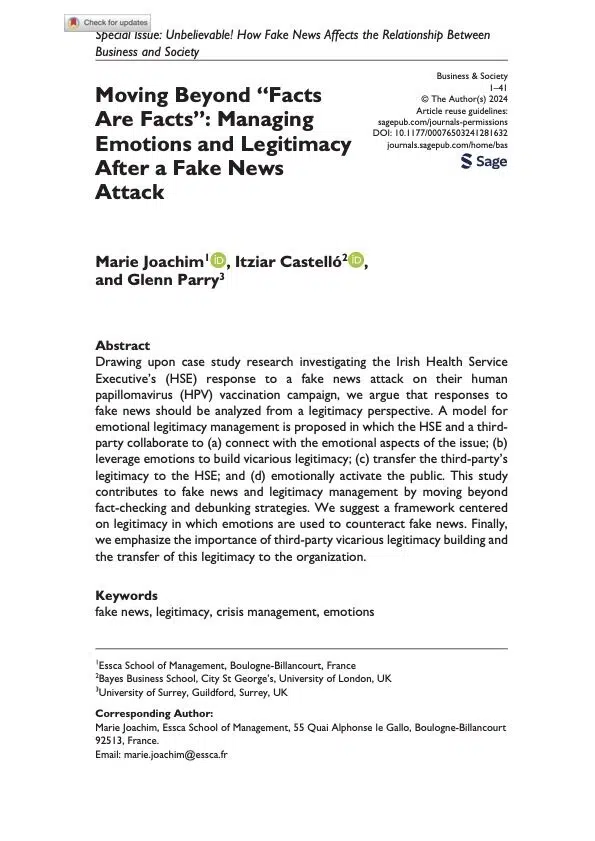How emotions, combined with facts, can help organisations recover from fake news attacks
In the age of social media and rapid information sharing, fake news is a growing concern for organisations. It's no longer enough to correct false information with facts; emotional engagement has become a powerful tool for rebuilding trust and legitimacy. A case study from Ireland's Health Service Executive (HSE) provides key lessons on how to effectively manage a fake news crisis using emotion.
The fake news attack that rocked Ireland's HPV vaccination campaign
In 2015, Ireland's Health Service Executive (HSE) came under attack from the anti-vaccination group REGRET, which spread alarming fake news about the human papillomavirus (HPV) vaccine Gardasil. REGRET's campaign featured emotionally-charged stories of young women allegedly harmed by the vaccine. Despite the lack of scientific support for these claims, their message resonated deeply with the public. As a result, vaccination rates fell from 85% to 50% in just two years.
The HSE responded with a campaign focused on countering misinformation with scientific facts. Its slogan, 'Get the facts, get the vaccine', aimed to counter fear with logic. But while the message was factual, it had little impact on vaccination uptake. Why? Because the fake news campaign played on emotions - fear, doubt and uncertainty. Facts alone couldn't undo the emotional damage.
When facts fail: The power of emotional legitimacy
Organisations need to look beyond the facts when responding to fake news, according to this study. The authors analysed the HSE's response to the REGRET campaign and found that emotional legitimacy, not just factual accuracy, was key to rebuilding trust.
Enter Laura Brennan, a 25-year-old woman with terminal cervical cancer caused by HPV. Brennan contacted the HSE and offered to share her story. She became a powerful advocate, using her personal experience to connect emotionally with the public. As someone facing the devastating effects of HPV, Brennan's message cut through the noise. She wasn't just giving statistics - she was living proof of the consequences of not being vaccinated.
Building trust through third-party advocacy
Brennan's involvement highlights another key finding: third-party advocacy plays a crucial role in regaining legitimacy after a fake news attack. As a neutral, independent figure, Brennan gave the HSE credibility in a way that the organisation's scientific messages couldn't. She acted as an emotional bridge between the HSE and the public, transferring her personal legitimacy to the organisation.
Her emotional story - told through media appearances, interviews and social media - was authentic and relatable. It was this emotional authenticity, rather than scientific facts, that helped to rebuild trust in the HPV vaccination programme. Over time, vaccination rates rose to 74%, demonstrating the effectiveness of this emotional strategy.
How emotions drive legitimacy
The study also points to the concept of "emotional legitimacy management". This involves connecting with the emotional side of an issue, rather than just the rational side. Fake news often thrives on emotional narratives because they are more memorable and persuasive than facts. To counter this, organisations need to manage emotions strategically.
In the HSE case, Brennan acted as what scientists call an "emotional battery" - someone who can generate strong emotional energy, whether positive or negative. Brennan's personal battle with cervical cancer evoked emotions of sympathy, urgency and fear about the disease, directly countering the fear stoked by REGRET. By engaging the public emotionally, the HSE shifted the conversation from one based on fear of the vaccine to fear of the consequences of not being vaccinated. It then turned it into something positive and hopeful, empowering people to take action to eradicate cervical cancer.
Lessons for organisations facing fake news
So what can other organisations learn from the HSE's experience? The most important lesson is that facts alone rarely win the battle against fake news. People's beliefs are shaped not only by information, but also by how that information makes them feel.
Here are three strategies, based on the HSE case, that can help organisations recover from fake news attacks:
- Connect emotionally: Scientific facts shouldn't be the only tool in your arsenal. Find ways to connect with the emotional aspects of the issue. In the case of the HSE, the personal story of a terminally ill patient created a far stronger emotional connection than data ever could.
- Leverage third-party legitimacy: Find advocates who can speak on your behalf. Their emotional and personal connection to the issue can lend credibility and trust that organisations perceived as bureaucratic often lack.
- Activate the public: Use emotional energy to inspire public action. The HSE's campaign, with Brennan's help, moved the public from hesitation to acceptance of vaccination. It wasn't the facts that convinced them - it was the emotional resonance of Brennan's story.
To conclude
Fake news is more than a battle of facts; it's a battle of hearts and minds. As the HSE's experience shows, rebuilding trust requires more than logical arguments. Organisations need to tap into the emotional pulse of their audiences, using personal stories and third-party advocates to regain legitimacy. In the post-truth era, emotions are as powerful as facts.
Joachim, M., Castelló, I., & Parry, G. (2024). Moving Beyond “Facts Are Facts”: Managing Emotions and Legitimacy After a Fake News Attack. Business & Society, 0(0). https://doi.org/10.1177/00076503241281632






